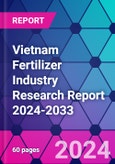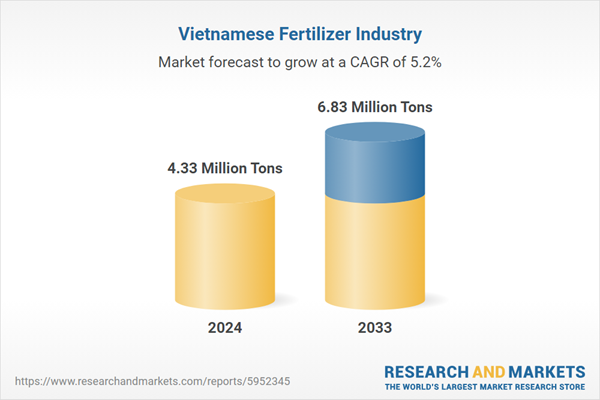According to the publisher's analysis, Vietnam's fertilizer market concentration is low, with local companies accounting for about 70% of the market share. Based on the overall revenue of the Vietnam fertilizer market in 2023, the top five companies together account for approximately 30% of the market. Major fertilizer manufacturers in the Vietnamese market are adopting various strategies, such as expanding production capacity and finding more distributors, to increase their market share.
The main types of chemical fertilizers exported by Vietnam are ammonium sulfate, diamine phosphate, nitrogen, phosphorus and potassium, etc. Cambodia, India, Indonesia, South Korea, Malaysia, the Philippines and other countries are the main export markets for Vietnamese fertilizers. At the same time, Vietnam imports more than 4 million tons of fertilizers every year, of which ammonium sulfate imports the largest amount. According to the publisher's analysis, China is currently Vietnam's largest fertilizer supplier, accounting for nearly 45% of Vietnam's total fertilizer imports. In addition, Russia, Israel, Laos, Canada and other countries are also the main import sources of fertilizers in Vietnam.
According to the publisher's analysis, although COVID -19 has had a certain impact on Vietnam's economy, Vietnam's fertilizer industry still showed a growth trend during the epidemic, and its fertilizer output increased by 5.2% and 3.5% respectively in 2020-2021. In addition, although the supply chain and logistics were disrupted during the epidemic, the export and import volume of fertilizers still showed an overall upward trend. Vietnam's fertilizer imports will reach 4.116 million tons in 2023, a year-on-year increase of 21.3%.
But in 2023, due to oversupply in the global fertilizer industry, fertilizer prices have fallen, and fewer foreign orders have led to a decline in Vietnam's fertilizer exports. However, as a net importer of fertilizers, Vietnam has experienced lower fertilizer prices in the process. China has also benefited. In 2023, Vietnam's fertilizer import volume increased by 21.3% year-on-year, but the import value dropped by 12.8% year-on-year.
The publisher predicts that with the development of Vietnam's agriculture and planting industry, Vietnam's chemical fertilizer imports will gradually increase in the next few years. The publisher predicts that Vietnam's fertilizer imports will reach 6.83 million tons by 2033, with a compound annual growth rate (CAGR) of 5.2% from 2024 to 2033.
Topics covered:
- Overview of Vietnam's Fertilizer Industry
- Economic environment and policy environment for fertilizers in Vietnam
- Vietnam fertilizer market size from 2019 to 2023
- Analysis of major Vietnamese fertilizer manufacturers
- Main driving forces and market opportunities of Vietnam’s fertilizer industry
- What are the main drivers, challenges and opportunities for Vietnam's fertilizer industry during the forecast period 2024-2033?
- What is the expected revenue of Vietnam Fertilizer market during the forecast period 2024-2033?
- What strategies are adopted by the key players in the market to increase their market share in the industry?
- Which segment of the Vietnam Fertilizer Market is expected to dominate the market in 2033?
- Vietnam Fertilizer Market Forecast from 2024 to 2033
- What are the main negative factors facing Vietnam’s fertilizer industry?
Table of Contents
Companies Mentioned
- Binh Dien Fertilizer JSC
- BFC
- Southern Fertilizer JSC
- PetroVietnam Fertilizer and Chemical Corp.
- Ninh Binh Phosphate Fertilizer JSC
- Habac Nitrogenous Fertilizer & Chemicals Company Limited
- Lam Thao Fertilizers and Chemicals JSC
- Que Lam Group
- Agricultural Products and Materials JSC
- APROMACO
- Song Gianh Corporation
- Thien Sinh JSC
- DAP Dinh Vu Fertilizers
- DUC Giang Chemicals
Methodology
Background research defines the range of products and industries, which proposes the key points of the research. Proper classification will help clients understand the industry and products in the report.
Secondhand material research is a necessary way to push the project into fast progress. The analyst always chooses the data source carefully. Most secondhand data they quote is sourced from an authority in a specific industry or public data source from governments, industrial associations, etc. For some new or niche fields, they also "double-check" data sources and logics before they show them to clients.
Primary research is the key to solve questions, which largely influence the research outputs. The analyst may use methods like mathematics, logical reasoning, scenario thinking, to confirm key data and make the data credible.
The data model is an important analysis method. Calculating through data models with different factors weights can guarantee the outputs objective.
The analyst optimizes the following methods and steps in executing research projects and also forms many special information gathering and processing methods.
1. Analyze the life cycle of the industry to understand the development phase and space.
2. Grasp the key indexes evaluating the market to position clients in the market and formulate development plans
3. Economic, political, social and cultural factors
4. Competitors like a mirror that reflects the overall market and also market differences.
5. Inside and outside the industry, upstream and downstream of the industry chain, show inner competitions
6. Proper estimation of the future is good guidance for strategic planning.

LOADING...
Table Information
| Report Attribute | Details |
|---|---|
| No. of Pages | 60 |
| Published | April 2024 |
| Forecast Period | 2024 - 2033 |
| Estimated Market Value in 2024 | 4.33 Million Tons |
| Forecasted Market Value by 2033 | 6.83 Million Tons |
| Compound Annual Growth Rate | 5.2% |
| Regions Covered | Vietnam |
| No. of Companies Mentioned | 14 |









